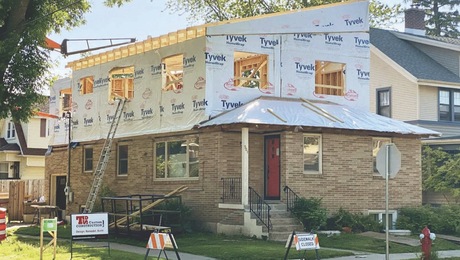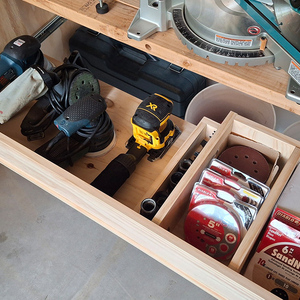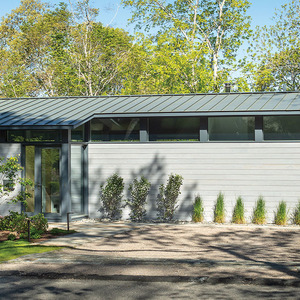I’m installing a 3/4″ random width (4″ to 11″) beech floor over the two layers of existing wide pine flooring (both of which are running in the same direction- perpendicular to the floor joists- thus one of the problems, spaces between the boards straight through to the basement). The house is 150+ years old- a rental duplex for the last 100. I’m upgrading it- complete restoration, and keeping with its historical roots. …..And hoping to get like minded, neat tenants this summer…
I have run a border board (5″) around the perimeter of the room with mitered corners to dress up the room and square off the out of square room. Now I am ready to cut and lay the plank flooring. I’m going to lay rosin paper down before securing the boards to the floor.
Two questions:
1) What is the best method for securing the flooring down to the 2 layers of pine? I am laying this floor perpendicular to the pine, therefore, parallel to the joists. I will be nailing or screwing into the pine planks (3/4″ thick each layer, thus 1 1/2″ to nail into). I’ve been wavering between the traditional cut nails vs using a finish nail gun- faster and somewhat hidden fastening. Or will the cut nails come loose over time and have to be renailed anyway? Or use a combination of both? And what spacing should I use?
2) What do I do about shrinkage/ moisture content in May- when it’s just rained for the last 5 days? (I’m in N.H.) I’ve back finished all the boards, I’m thinking I’m going to have to somehow run them all through a joiner (which I don’t have), since the mill finished edges are not truly finished, or square. Then maybe finish the edges too, to help stabilize the moisture in all the boards. I’m using Varathane oil finish.
Any help or input would be truly appreciated.
Thanks everyone.
Sal



















Replies
Your options for fastening the floor, are really limited to face fastening as you are running boards up to 11" wide. I try to limit my blind or edge nailing to 6" maximum and only if the boards are matched (t&g).
Cut nails look nice, but in your situation, time may loosen the fastening as your three courses of flooring move. I have been screwing and plugging my wide plank floors with appealing results. I usually use 32" centers for my fastening, staggering every course at 16". That way the floor does not become too busy. Two screws per board. And try a contrasting plug, or at least perpendicular to the grain of your floor. It is impossible to hide every plug so why not accent them. Cherry or walnut may look nice against the beech.
Using plugs and a 2" screw will give you an excellent connection and help stiffen your under floor to reduce any potential problems running parallel to your joists.
The only good time to lay flooring is when the moisture level is at it's lowest, both in flooring and in subfloor. With the random width you can expect some movement, but if the flooring and subfloor are 7-8% at install, I think it can be kept to a minimum.
I am not in favour of sealing all sides of flooring, as you can create unequal moisture related pressures and develope checking or even splits, especially in wide planks and not optimum dryness.
iv'e never had much luck with beech--lots of movement--11" is way too wide. You should rethink this project!
Did someone actually sell you beech as a flooring product??
Beech is an EXCELLENT pallet wood!
There is a reason for this.
Lots of movement i.e. twist, cup, warp, bow, and uneven shrinkage.
Other than these minor problems it will make a nice floor!!
I suggest botling it down with 3/8 lags and fender washers and finishing it with 4" of 4000psi concrete with lots of reinforcing.
Then stain the crete a nice leather brown.
Mr T
Do not try this at home!
I am an Experienced Professional!
I had a crusty shop teacher (God rest his weary soul) that would sight down a plank of beech, and yell loudly, "Son of a beech, ain't never gonna get a straight piece'a wood from a beech tree!"
Never thought much of the stuff since then.
I never met a tool I didn't like!
Beech is as hard as a mother-in-laws heart and has the same disposition.Ditch
Sal,
What kind of beech is it? Is this tongue and groove planking manufactured by a wood mill or just plain 4/4 stock? Lastly do you know anything about how it has been dried?
Yes, beech is notorious for moving more than any other wood. However, how it is dried has a very big effect on movement after the fact. As long as it has been kiln dried in the proper method, you shouldn't have too many problems. It will still move more than any other type of floor though (but that's not necessarily bad).
I agree with the decision to seal all 6 sides (or at least the back side). This will definitely slow the migration of water in and out of the entire floor and as long as the relative humidity in the house is somewhat controlled, you should be alright.
Good luck.
Rob Kress
OK, I WAS feeling pretty good about my flooring decision, after the first reply. But now,,,,,, well, maybe it will be better than the wide pine that is already there (and was painted, before I stripped it... and still paint blotchy.)....
Well, anyway, the beech was dried in a hardwood drying kiln, here in the seacoast of NH, by a lumber yard that cuts their own wood. I'm having the edges cleaned up at the local vo-tech high school, as we speak. (It's 4/4 stock) The "building trades" teacher didn't say anything about it being a problem for floors, and they build houses as the teaching mechanism for the hs. students. He recommended, as did the first post, to screw and plug the floor. It will be screwed into the two layers of pine flooring, since they are both running perp. to the joists, and this will be parallel to the joists.
Any other great words of wisdom? I'm all ready........ :)
I've at least figured out from all postings, that chamfering the edges is a really bad idea. (was recommended by a wood working company here)... dirt in the grooves, etc.
~Sal
Edited 5/31/2003 2:42:21 PM ET by Sal
Sal, Any wood plank floor, especially with widths up to 11" is going to be unstable. By this I mean it will have a greater tendency to move ( shrink and expand seasonally across the grain) and have a greater potential for cupping. Also with this movement comes a greater risk of splitting and/or checking due to pressures generated in the boards by the fastening.
This is a well known fact and creates the challenge with working with wood, either as flooring, building furniture or trim etc. This is why so much of our flooring is milled as strip flooring, usually in dimensions under 3-1/4" widths. It provides easier install with the tongue nailing, but it also allows greater stability in the finished product.
Now that I have said all that, let me say that there is a beauty in wide plank flooring that compensates for the gaps, possible checking and cupping that can be associated with plank flooring. Many of the problems can be mitigated by proper installation, which requires time and thought.
Some additional tips on install if you choose to use the wide plank. You can mill in relief kerfs on the bottom of the flooring. These will help relieve pressure and reduce the potential for cupping. I generally run a saw kerf, 1/4" deep and 2-2-1/2" apart and from the edges.
Having your flooring milled as matched boards with end maching greatly helps. If end matching is not available I use a router with a slotting bit and spline my ends as I install the flooring.
Do not over fasten your flooring. Two fasteners per board width is all you should use. You can increase the distance from the edge to accommadate wider planks. I usually start with 1" from edge for wood up to 6" in width. For 11", I would stay 2" from the edge.
There is always the on going debate about sealing or not sealing all edges of wood. I believe that sealing all surfaces with a non breathable finish causes more problems than it solves. I generally use a oil-modified polyurethane as my floor finish, but only on the surface. Preferably, a penetrating oil finish should be used. It still allows the wood to breathe, but also replenishs the lost oils in the wood and creates improved stability y allowing less moisture to be absorbed by the wood.
For plugs, use a face grain plug rather than an end grain. I do not try to match the plug and the flooring, but rather use the plug as an accent. I'd use cherry plugs with birch flooring and run the grain perpendicular. 1/2" plugs, use a forstner bit first, then drill for the screw.
walk good
Thanks for all the good input. I'm hopefully going to be installing it this week June 2-6.
I've already back primed the planks with Varathane, so will just "stop" with that, vs edges as well. Will be following all advice as well as possible.
Dthodal, could you explain end matching and splining the ends? I can guess that splining the ends is sort of like creating my own tongue and groove, with the tongue being a separate piece of wood, kind of like a biscuit? And how close to the ends should I screw- 2"? I'm planning on predrilling all the holes for fastening- every 2 feet, along the length of each board, yes?
Again, thanks all for the help. Will stop back in with the results when it's done.
~Sal
" could you explain end matching and splining the ends? "
Eactly right. I use a 1/4 slotting bit with bushing to match depth of milled groove. Splines are cut from scraps of wood to be just shy of groove depth x 2. The spline is then driven in after the two grooved ends are butted and fastened.
The spline helps keep the ends tighter but help also in minimizing cupping.
I keep my screw/plugs about 3" from the ends. And do both ends. Generally I am screwing through only 3/4" subfloor, so I try to keep my screws into joists as well. My pattern is generally 32" centers (on 16" joist layout) with each course offset from th previous course by 16".
Since you are screwing into a double subfloor (1-1/2") you can start any pattern you want. I would keep it to a minimum of 24" centers like you mentioned, and offset each course 12".
Predrill your plug hole first then center your pilot for the screw.
walk good
Thanks Dthodal, will be starting on it tomorrow.
~Sal